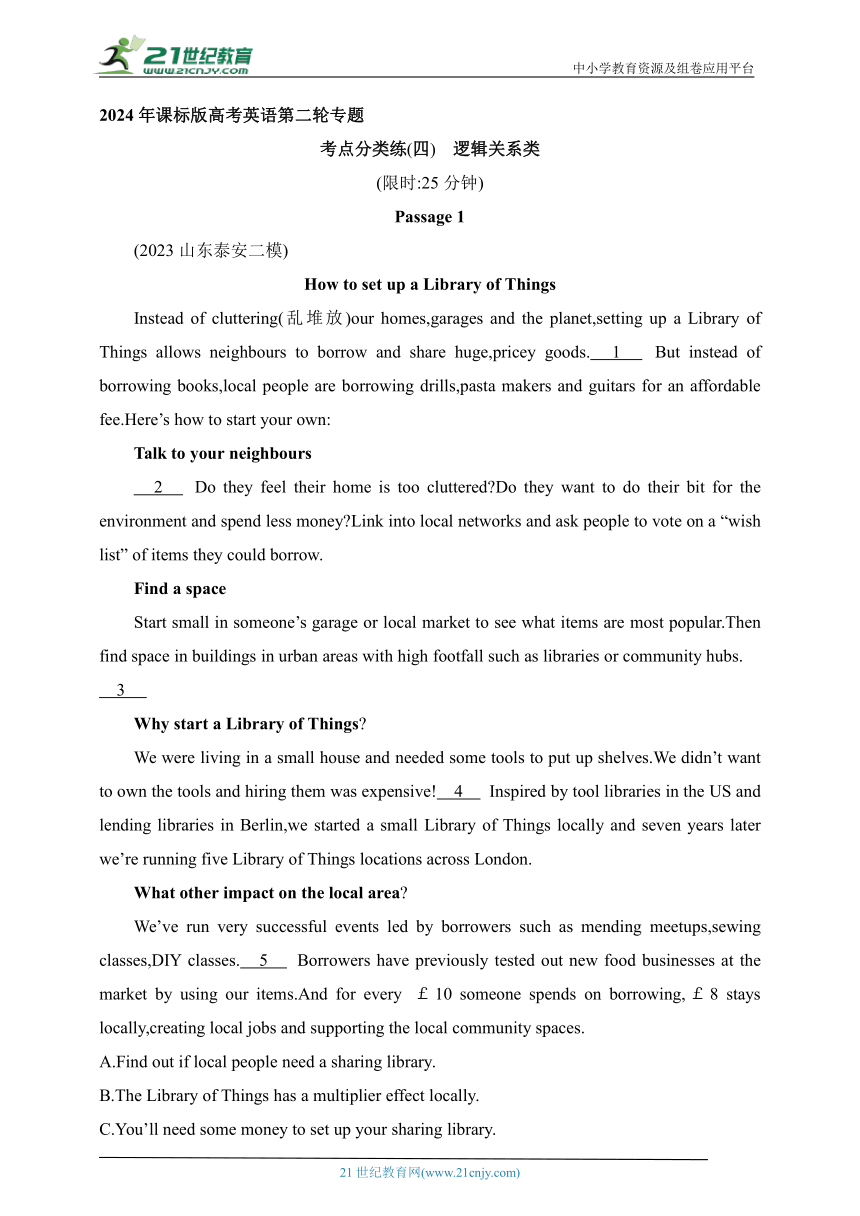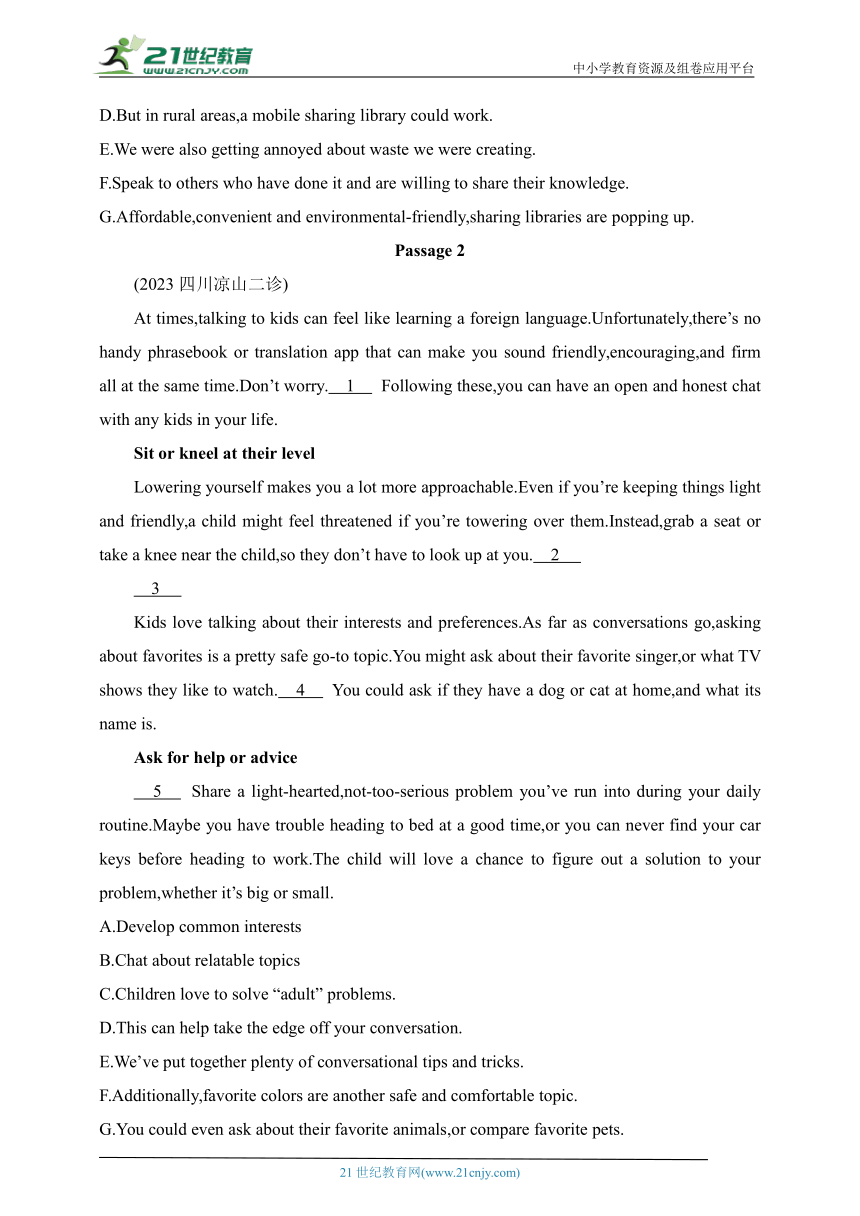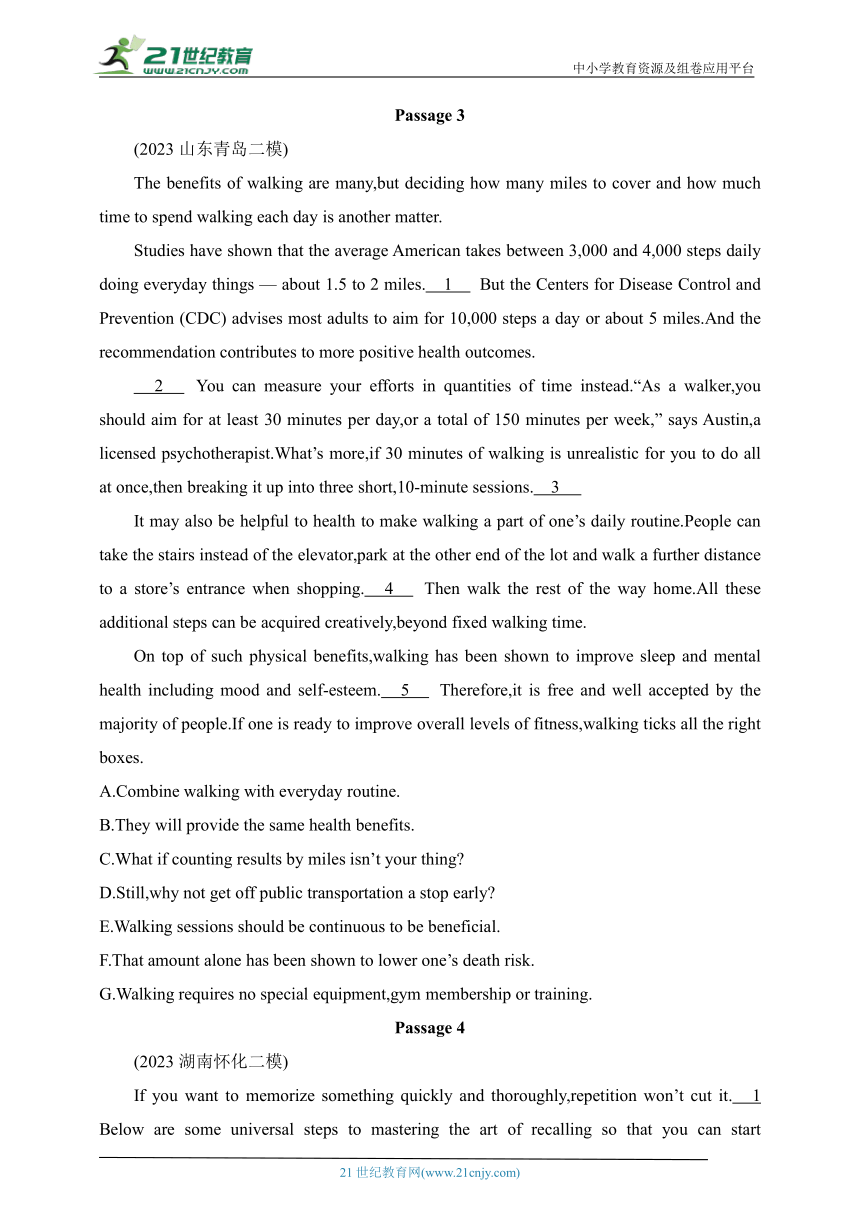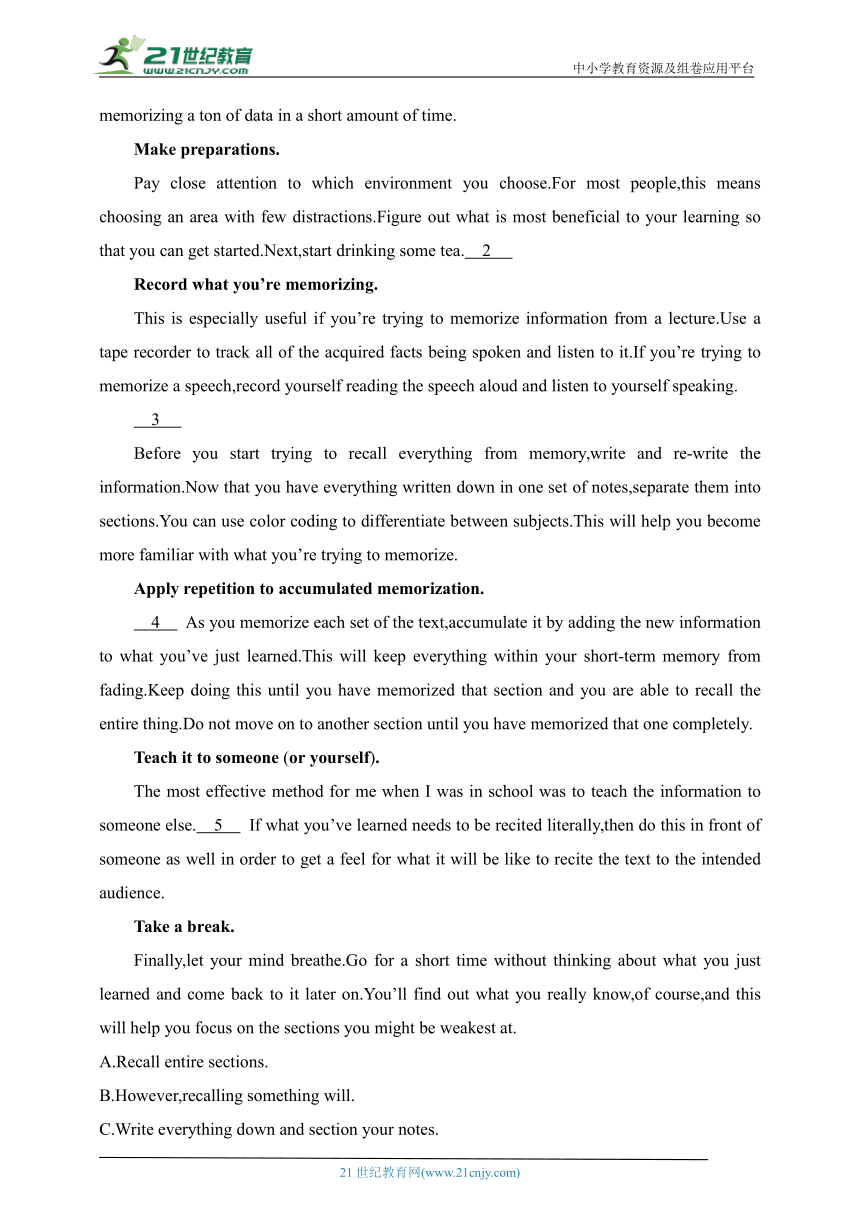2024年课标版高考英语第二轮专题练习--七选五 考点分类练4 逻辑关系类(含答案与解析)
文档属性
| 名称 | 2024年课标版高考英语第二轮专题练习--七选五 考点分类练4 逻辑关系类(含答案与解析) |  | |
| 格式 | docx | ||
| 文件大小 | 1022.1KB | ||
| 资源类型 | 试卷 | ||
| 版本资源 | 通用版 | ||
| 科目 | 英语 | ||
| 更新时间 | 2023-11-03 12:42:08 | ||
图片预览




文档简介
中小学教育资源及组卷应用平台
2024年课标版高考英语第二轮专题
考点分类练(四) 逻辑关系类
(限时:25分钟)
Passage 1
(2023山东泰安二模)
How to set up a Library of Things
Instead of cluttering(乱堆放)our homes,garages and the planet,setting up a Library of Things allows neighbours to borrow and share huge,pricey goods. 1 But instead of borrowing books,local people are borrowing drills,pasta makers and guitars for an affordable fee.Here’s how to start your own:
Talk to your neighbours
2 Do they feel their home is too cluttered Do they want to do their bit for the environment and spend less money Link into local networks and ask people to vote on a “wish list” of items they could borrow.
Find a space
Start small in someone’s garage or local market to see what items are most popular.Then find space in buildings in urban areas with high footfall such as libraries or community hubs.
3
Why start a Library of Things
We were living in a small house and needed some tools to put up shelves.We didn’t want to own the tools and hiring them was expensive! 4 Inspired by tool libraries in the US and lending libraries in Berlin,we started a small Library of Things locally and seven years later we’re running five Library of Things locations across London.
What other impact on the local area
We’ve run very successful events led by borrowers such as mending meetups,sewing classes,DIY classes. 5 Borrowers have previously tested out new food businesses at the market by using our items.And for every £10 someone spends on borrowing,£8 stays locally,creating local jobs and supporting the local community spaces.
A.Find out if local people need a sharing library.
B.The Library of Things has a multiplier effect locally.
C.You’ll need some money to set up your sharing library.
D.But in rural areas,a mobile sharing library could work.
E.We were also getting annoyed about waste we were creating.
F.Speak to others who have done it and are willing to share their knowledge.
G.Affordable,convenient and environmental-friendly,sharing libraries are popping up.
Passage 2
(2023四川凉山二诊)
At times,talking to kids can feel like learning a foreign language.Unfortunately,there’s no handy phrasebook or translation app that can make you sound friendly,encouraging,and firm all at the same time.Don’t worry. 1 Following these,you can have an open and honest chat with any kids in your life.
Sit or kneel at their level
Lowering yourself makes you a lot more approachable.Even if you’re keeping things light and friendly,a child might feel threatened if you’re towering over them.Instead,grab a seat or take a knee near the child,so they don’t have to look up at you. 2
3
Kids love talking about their interests and preferences.As far as conversations go,asking about favorites is a pretty safe go-to topic.You might ask about their favorite singer,or what TV shows they like to watch. 4 You could ask if they have a dog or cat at home,and what its name is.
Ask for help or advice
5 Share a light-hearted,not-too-serious problem you’ve run into during your daily routine.Maybe you have trouble heading to bed at a good time,or you can never find your car keys before heading to work.The child will love a chance to figure out a solution to your problem,whether it’s big or small.
A.Develop common interests
B.Chat about relatable topics
C.Children love to solve “adult” problems.
D.This can help take the edge off your conversation.
E.We’ve put together plenty of conversational tips and tricks.
F.Additionally,favorite colors are another safe and comfortable topic.
G.You could even ask about their favorite animals,or compare favorite pets.
Passage 3
(2023山东青岛二模)
The benefits of walking are many,but deciding how many miles to cover and how much time to spend walking each day is another matter.
Studies have shown that the average American takes between 3,000 and 4,000 steps daily doing everyday things — about 1.5 to 2 miles. 1 But the Centers for Disease Control and Prevention (CDC) advises most adults to aim for 10,000 steps a day or about 5 miles.And the recommendation contributes to more positive health outcomes.
2 You can measure your efforts in quantities of time instead.“As a walker,you should aim for at least 30 minutes per day,or a total of 150 minutes per week,” says Austin,a licensed psychotherapist.What’s more,if 30 minutes of walking is unrealistic for you to do all at once,then breaking it up into three short,10-minute sessions. 3
It may also be helpful to health to make walking a part of one’s daily routine.People can take the stairs instead of the elevator,park at the other end of the lot and walk a further distance to a store’s entrance when shopping. 4 Then walk the rest of the way home.All these additional steps can be acquired creatively,beyond fixed walking time.
On top of such physical benefits,walking has been shown to improve sleep and mental health including mood and self-esteem. 5 Therefore,it is free and well accepted by the majority of people.If one is ready to improve overall levels of fitness,walking ticks all the right boxes.
A.Combine walking with everyday routine.
B.They will provide the same health benefits.
C.What if counting results by miles isn’t your thing
D.Still,why not get off public transportation a stop early
E.Walking sessions should be continuous to be beneficial.
F.That amount alone has been shown to lower one’s death risk.
G.Walking requires no special equipment,gym membership or training.
Passage 4
(2023湖南怀化二模)
If you want to memorize something quickly and thoroughly,repetition won’t cut it. 1 Below are some universal steps to mastering the art of recalling so that you can start memorizing a ton of data in a short amount of time.
Make preparations.
Pay close attention to which environment you choose.For most people,this means choosing an area with few distractions.Figure out what is most beneficial to your learning so that you can get started.Next,start drinking some tea. 2
Record what you’re memorizing.
This is especially useful if you’re trying to memorize information from a lecture.Use a tape recorder to track all of the acquired facts being spoken and listen to it.If you’re trying to memorize a speech,record yourself reading the speech aloud and listen to yourself speaking.
3
Before you start trying to recall everything from memory,write and re-write the information.Now that you have everything written down in one set of notes,separate them into sections.You can use color coding to differentiate between subjects.This will help you become more familiar with what you’re trying to memorize.
Apply repetition to accumulated memorization.
4 As you memorize each set of the text,accumulate it by adding the new information to what you’ve just learned.This will keep everything within your short-term memory from fading.Keep doing this until you have memorized that section and you are able to recall the entire thing.Do not move on to another section until you have memorized that one completely.
Teach it to someone (or yourself).
The most effective method for me when I was in school was to teach the information to someone else. 5 If what you’ve learned needs to be recited literally,then do this in front of someone as well in order to get a feel for what it will be like to recite the text to the intended audience.
Take a break.
Finally,let your mind breathe.Go for a short time without thinking about what you just learned and come back to it later on.You’ll find out what you really know,of course,and this will help you focus on the sections you might be weakest at.
A.Recall entire sections.
B.However,recalling something will.
C.Write everything down and section your notes.
D.You can lecture the knowledge to someone sitting right in front of you.
E.For each line of the text,repeat it a few times and try to recall it without looking.
F.While doing unrelated tasks,go over the information by listening to your tape recordings.
G.Many scientific studies have confirmed green tea as a natural fuel for improving memory.
答案:
Passage 1
[语篇解读]本文是一篇说明文。文章介绍了开设一家共享物品馆的步骤和它对社会经济产生的积极作用。
1.G 上文“Instead of cluttering our homes,garages and the planet,setting up a Library of Things allows neighbours to borrow and share huge,pricey goods.”提到要建立物品馆,可知,空处承接上文,指出物品馆出现了,与G项“价格合理、方便且环保的共享物品馆正在涌现”符合,同时和下文“But instead of borrowing books,local people are borrowing drills,pasta makers and guitars for an affordable fee.”构成转折关系,说明虽然共享物品馆涌现,但是人们没有去借书而是租借了其他物品。
2.A 根据下文“Link into local networks and ask people to vote on a ‘wish list’ of items they could borrow.”可知,通过链接可以让人们对于可以借的物品进行投票是对A项“了解当地人是否需要共享物品馆”内容的承接,指出了解当地人是否对共享物品馆有需求这一问题的具体做法就是通过在网上让人们投票。
3.D 根据上文“Then find space in buildings in urban areas with high footfall such as libraries or community hubs.”可知,上文介绍了在城市的哪些地方可以找到空间建立共享物品馆,与D项“但在农村地区,移动共享物品馆可以发挥作用”构成转折关系,表明在乡村地区共享物品馆的形式和城市中的情况有所不同。
4.E 根据上文“We were living in a small house and needed some tools to put up shelves.We didn’t want to own the tools and hiring them was expensive!”可知,我们不想为搭架子的工具花钱,和E项“我们也对自己制造的浪费感到恼火”都是对小标题“为什么建立物品馆”的原因举例说明。
5.B 上文“We’ve run very successful events”及下文“Borrowers have previously tested out new food businesses...creating local jobs and supporting the local community spaces.”是对B项“物品馆在当地具有乘数效应”中的 multiplier effect这一概念进行了解释说明,乘数效应是指在公共工程项目之后带来的消费水平和私人投资水平的上升,因为物品馆举办的活动使人们的就业机会增加并支持了当地的社区空间。
Passage 2
[语篇解读]本文是一篇说明文。文章介绍了与孩子进行坦诚交谈的策略。
1.E E项与上文“Unfortunately,there’s no handy phrasebook or translation app that can make you sound friendly,encouraging,and firm all at the same time.Don’t worry.”形成转折,表明虽然没有与孩子进行坦诚交流的手册或应用软件,但这篇文章中给出了相关建议或技巧(这也是文章的目的所在),且下文“Following these,you can have an open and honest chat with any kids in your life.”中的“these”指代E项中的“plenty of conversational tips and tricks”。故选E项。
2.D 由上文“Lowering yourself makes you a lot more approachable...so they don’t have to look up at you.”可知,家长位置比孩子高会让孩子感到威胁,作者举例相反的情况,家长拿把椅子坐下或者跪下靠近孩子,孩子就不用仰视父母,这是在说父母和孩子谈话时在孩子的水平坐或者跪的好处。故选D项。
3.B 该空选择小标题,需总结下文。由下文可知,想要与孩子进行坦诚交谈,作者建议谈论与孩子们的生活息息相关的话题。故选B项。
4.G G项引出与孩子们的生活息息相关的话题之一——谈论宠物,才可衔接下文“You could ask if they have a dog or cat at home,and what its name is.”。故选G项。
5.C 由小标题“Ask for help or advice”可知,想要与孩子进行坦诚交谈,作者建议大人们要向孩子们寻求帮助或建议,该空应该提及父母们可以这样做的原因,C项可以是其原因,呼应下文“The child will love a chance to figure out a solution to your problem,whether it’s big or small.”。故选C项。
Passage 3
[语篇解读]本文是一篇说明文。文章主要介绍了日常生活中步行的好处。
1.F 根据空前“Studies have shown that the average American takes between 3,000 and 4,000 steps daily doing everyday things — about 1.5 to 2 miles.”可知,这里继续介绍每天走3000到4000步的好处——可以降低死亡风险。故选F项。
2.C 根据空后“You can measure your efforts in quantities of time instead.”可知,如果不喜欢用多少英里计算步行,也可以用时间来衡量。所以C项 “What if counting results by miles isn’t your thing ”符合上下文语境。
3.B 根据空前“What’s more,if 30 minutes of walking is unrealistic for you to do all at once,then breaking it up into three short,10-minute sessions.”可知,不管是连续步行30分钟还是分成三个10分钟完成都能达到同样的健康好处。所以B项“They will provide the same health benefits.”符合上下文语境。
4.D 根据空后“Then walk the rest of the way home.”可知,这里介绍日常生活中坐公共汽车可以提前一站下车,走着回家,达到步行锻炼的目的。故选D项。
5.G 根据空后“Therefore,it is free and well accepted by the majority of people.”可知,前后句是因果关系,说明步行免费的原因——不需要特殊的设备,也不需要会员资格或训练。故选G项。
Passage 4
[语篇解读]本文是一篇说明文。文章主要介绍了可以在短时间内记住大量数据的方法。
1.B 上文“If you want to memorize something quickly and thoroughly,repetition won’t cut it.”说明重复不会快速、彻底地记住某件事,与空格处是转折关系,因此B项“然而,回忆一些事情会的”符合语境。
2.G 上文“Next,start drinking some tea.”说明准备期间喝些茶,因此G项“许多科学研究已经证实绿茶是一种提高记忆力的天然燃料”符合语境。
3.C 下文“Now that you have everything written down in one set of notes,separate them into sections.”说明要把事情记下来并且合理分组,因此C项“把所有的东西都写下来,并区分你的笔记”概括段意。
4.E 本段主旨句“Apply repetition to accumulated memorization.”强调重复的重要性,因此E项“对于每一行文本,重复几次,试着不看就回忆起来”符合语境。
5.D 上文“The most effective method for me when I was in school was to teach the information to someone else.”说明于作者而言,教授他人知识是最有效的方法,因此D项“你可以把知识传授给坐在你面前的人”符合语境。
词汇积累:
1.(Passage 1)vote on就……进行投票表决
2.(Passage 1)put up建造
3.(Passage 1)test out测试
4.(Passage 2)handy adj.手边的,便于使用的
5.(Passage 2)kneel vi.跪下
6.(Passage 2)light-hearted adj.轻松的
7.(Passage 2)daily routine 日常事务
8.(Passage 3)cover行走(一段路程)
9.(Passage 3)a total of总共
10.(Passage 3)on top of除……之外(还)
11.(Passage 4)accumulate vt.积累
长难句分析:
(Passage 4)As you memorize each set of the text,accumulate it by adding the new information to what you’ve just learned.
分析:本句为复合句。As you memorize each set of the text为as引导的时间状语从句;what you’ve just learned为what引导的宾语从句。
句意:当你记忆每一组课文的时候,通过在你刚学过的内容上添加新的信息来积累它。
21世纪教育网 www.21cnjy.com 精品试卷·第 2 页 (共 2 页)
21世纪教育网(www.21cnjy.com)
2024年课标版高考英语第二轮专题
考点分类练(四) 逻辑关系类
(限时:25分钟)
Passage 1
(2023山东泰安二模)
How to set up a Library of Things
Instead of cluttering(乱堆放)our homes,garages and the planet,setting up a Library of Things allows neighbours to borrow and share huge,pricey goods. 1 But instead of borrowing books,local people are borrowing drills,pasta makers and guitars for an affordable fee.Here’s how to start your own:
Talk to your neighbours
2 Do they feel their home is too cluttered Do they want to do their bit for the environment and spend less money Link into local networks and ask people to vote on a “wish list” of items they could borrow.
Find a space
Start small in someone’s garage or local market to see what items are most popular.Then find space in buildings in urban areas with high footfall such as libraries or community hubs.
3
Why start a Library of Things
We were living in a small house and needed some tools to put up shelves.We didn’t want to own the tools and hiring them was expensive! 4 Inspired by tool libraries in the US and lending libraries in Berlin,we started a small Library of Things locally and seven years later we’re running five Library of Things locations across London.
What other impact on the local area
We’ve run very successful events led by borrowers such as mending meetups,sewing classes,DIY classes. 5 Borrowers have previously tested out new food businesses at the market by using our items.And for every £10 someone spends on borrowing,£8 stays locally,creating local jobs and supporting the local community spaces.
A.Find out if local people need a sharing library.
B.The Library of Things has a multiplier effect locally.
C.You’ll need some money to set up your sharing library.
D.But in rural areas,a mobile sharing library could work.
E.We were also getting annoyed about waste we were creating.
F.Speak to others who have done it and are willing to share their knowledge.
G.Affordable,convenient and environmental-friendly,sharing libraries are popping up.
Passage 2
(2023四川凉山二诊)
At times,talking to kids can feel like learning a foreign language.Unfortunately,there’s no handy phrasebook or translation app that can make you sound friendly,encouraging,and firm all at the same time.Don’t worry. 1 Following these,you can have an open and honest chat with any kids in your life.
Sit or kneel at their level
Lowering yourself makes you a lot more approachable.Even if you’re keeping things light and friendly,a child might feel threatened if you’re towering over them.Instead,grab a seat or take a knee near the child,so they don’t have to look up at you. 2
3
Kids love talking about their interests and preferences.As far as conversations go,asking about favorites is a pretty safe go-to topic.You might ask about their favorite singer,or what TV shows they like to watch. 4 You could ask if they have a dog or cat at home,and what its name is.
Ask for help or advice
5 Share a light-hearted,not-too-serious problem you’ve run into during your daily routine.Maybe you have trouble heading to bed at a good time,or you can never find your car keys before heading to work.The child will love a chance to figure out a solution to your problem,whether it’s big or small.
A.Develop common interests
B.Chat about relatable topics
C.Children love to solve “adult” problems.
D.This can help take the edge off your conversation.
E.We’ve put together plenty of conversational tips and tricks.
F.Additionally,favorite colors are another safe and comfortable topic.
G.You could even ask about their favorite animals,or compare favorite pets.
Passage 3
(2023山东青岛二模)
The benefits of walking are many,but deciding how many miles to cover and how much time to spend walking each day is another matter.
Studies have shown that the average American takes between 3,000 and 4,000 steps daily doing everyday things — about 1.5 to 2 miles. 1 But the Centers for Disease Control and Prevention (CDC) advises most adults to aim for 10,000 steps a day or about 5 miles.And the recommendation contributes to more positive health outcomes.
2 You can measure your efforts in quantities of time instead.“As a walker,you should aim for at least 30 minutes per day,or a total of 150 minutes per week,” says Austin,a licensed psychotherapist.What’s more,if 30 minutes of walking is unrealistic for you to do all at once,then breaking it up into three short,10-minute sessions. 3
It may also be helpful to health to make walking a part of one’s daily routine.People can take the stairs instead of the elevator,park at the other end of the lot and walk a further distance to a store’s entrance when shopping. 4 Then walk the rest of the way home.All these additional steps can be acquired creatively,beyond fixed walking time.
On top of such physical benefits,walking has been shown to improve sleep and mental health including mood and self-esteem. 5 Therefore,it is free and well accepted by the majority of people.If one is ready to improve overall levels of fitness,walking ticks all the right boxes.
A.Combine walking with everyday routine.
B.They will provide the same health benefits.
C.What if counting results by miles isn’t your thing
D.Still,why not get off public transportation a stop early
E.Walking sessions should be continuous to be beneficial.
F.That amount alone has been shown to lower one’s death risk.
G.Walking requires no special equipment,gym membership or training.
Passage 4
(2023湖南怀化二模)
If you want to memorize something quickly and thoroughly,repetition won’t cut it. 1 Below are some universal steps to mastering the art of recalling so that you can start memorizing a ton of data in a short amount of time.
Make preparations.
Pay close attention to which environment you choose.For most people,this means choosing an area with few distractions.Figure out what is most beneficial to your learning so that you can get started.Next,start drinking some tea. 2
Record what you’re memorizing.
This is especially useful if you’re trying to memorize information from a lecture.Use a tape recorder to track all of the acquired facts being spoken and listen to it.If you’re trying to memorize a speech,record yourself reading the speech aloud and listen to yourself speaking.
3
Before you start trying to recall everything from memory,write and re-write the information.Now that you have everything written down in one set of notes,separate them into sections.You can use color coding to differentiate between subjects.This will help you become more familiar with what you’re trying to memorize.
Apply repetition to accumulated memorization.
4 As you memorize each set of the text,accumulate it by adding the new information to what you’ve just learned.This will keep everything within your short-term memory from fading.Keep doing this until you have memorized that section and you are able to recall the entire thing.Do not move on to another section until you have memorized that one completely.
Teach it to someone (or yourself).
The most effective method for me when I was in school was to teach the information to someone else. 5 If what you’ve learned needs to be recited literally,then do this in front of someone as well in order to get a feel for what it will be like to recite the text to the intended audience.
Take a break.
Finally,let your mind breathe.Go for a short time without thinking about what you just learned and come back to it later on.You’ll find out what you really know,of course,and this will help you focus on the sections you might be weakest at.
A.Recall entire sections.
B.However,recalling something will.
C.Write everything down and section your notes.
D.You can lecture the knowledge to someone sitting right in front of you.
E.For each line of the text,repeat it a few times and try to recall it without looking.
F.While doing unrelated tasks,go over the information by listening to your tape recordings.
G.Many scientific studies have confirmed green tea as a natural fuel for improving memory.
答案:
Passage 1
[语篇解读]本文是一篇说明文。文章介绍了开设一家共享物品馆的步骤和它对社会经济产生的积极作用。
1.G 上文“Instead of cluttering our homes,garages and the planet,setting up a Library of Things allows neighbours to borrow and share huge,pricey goods.”提到要建立物品馆,可知,空处承接上文,指出物品馆出现了,与G项“价格合理、方便且环保的共享物品馆正在涌现”符合,同时和下文“But instead of borrowing books,local people are borrowing drills,pasta makers and guitars for an affordable fee.”构成转折关系,说明虽然共享物品馆涌现,但是人们没有去借书而是租借了其他物品。
2.A 根据下文“Link into local networks and ask people to vote on a ‘wish list’ of items they could borrow.”可知,通过链接可以让人们对于可以借的物品进行投票是对A项“了解当地人是否需要共享物品馆”内容的承接,指出了解当地人是否对共享物品馆有需求这一问题的具体做法就是通过在网上让人们投票。
3.D 根据上文“Then find space in buildings in urban areas with high footfall such as libraries or community hubs.”可知,上文介绍了在城市的哪些地方可以找到空间建立共享物品馆,与D项“但在农村地区,移动共享物品馆可以发挥作用”构成转折关系,表明在乡村地区共享物品馆的形式和城市中的情况有所不同。
4.E 根据上文“We were living in a small house and needed some tools to put up shelves.We didn’t want to own the tools and hiring them was expensive!”可知,我们不想为搭架子的工具花钱,和E项“我们也对自己制造的浪费感到恼火”都是对小标题“为什么建立物品馆”的原因举例说明。
5.B 上文“We’ve run very successful events”及下文“Borrowers have previously tested out new food businesses...creating local jobs and supporting the local community spaces.”是对B项“物品馆在当地具有乘数效应”中的 multiplier effect这一概念进行了解释说明,乘数效应是指在公共工程项目之后带来的消费水平和私人投资水平的上升,因为物品馆举办的活动使人们的就业机会增加并支持了当地的社区空间。
Passage 2
[语篇解读]本文是一篇说明文。文章介绍了与孩子进行坦诚交谈的策略。
1.E E项与上文“Unfortunately,there’s no handy phrasebook or translation app that can make you sound friendly,encouraging,and firm all at the same time.Don’t worry.”形成转折,表明虽然没有与孩子进行坦诚交流的手册或应用软件,但这篇文章中给出了相关建议或技巧(这也是文章的目的所在),且下文“Following these,you can have an open and honest chat with any kids in your life.”中的“these”指代E项中的“plenty of conversational tips and tricks”。故选E项。
2.D 由上文“Lowering yourself makes you a lot more approachable...so they don’t have to look up at you.”可知,家长位置比孩子高会让孩子感到威胁,作者举例相反的情况,家长拿把椅子坐下或者跪下靠近孩子,孩子就不用仰视父母,这是在说父母和孩子谈话时在孩子的水平坐或者跪的好处。故选D项。
3.B 该空选择小标题,需总结下文。由下文可知,想要与孩子进行坦诚交谈,作者建议谈论与孩子们的生活息息相关的话题。故选B项。
4.G G项引出与孩子们的生活息息相关的话题之一——谈论宠物,才可衔接下文“You could ask if they have a dog or cat at home,and what its name is.”。故选G项。
5.C 由小标题“Ask for help or advice”可知,想要与孩子进行坦诚交谈,作者建议大人们要向孩子们寻求帮助或建议,该空应该提及父母们可以这样做的原因,C项可以是其原因,呼应下文“The child will love a chance to figure out a solution to your problem,whether it’s big or small.”。故选C项。
Passage 3
[语篇解读]本文是一篇说明文。文章主要介绍了日常生活中步行的好处。
1.F 根据空前“Studies have shown that the average American takes between 3,000 and 4,000 steps daily doing everyday things — about 1.5 to 2 miles.”可知,这里继续介绍每天走3000到4000步的好处——可以降低死亡风险。故选F项。
2.C 根据空后“You can measure your efforts in quantities of time instead.”可知,如果不喜欢用多少英里计算步行,也可以用时间来衡量。所以C项 “What if counting results by miles isn’t your thing ”符合上下文语境。
3.B 根据空前“What’s more,if 30 minutes of walking is unrealistic for you to do all at once,then breaking it up into three short,10-minute sessions.”可知,不管是连续步行30分钟还是分成三个10分钟完成都能达到同样的健康好处。所以B项“They will provide the same health benefits.”符合上下文语境。
4.D 根据空后“Then walk the rest of the way home.”可知,这里介绍日常生活中坐公共汽车可以提前一站下车,走着回家,达到步行锻炼的目的。故选D项。
5.G 根据空后“Therefore,it is free and well accepted by the majority of people.”可知,前后句是因果关系,说明步行免费的原因——不需要特殊的设备,也不需要会员资格或训练。故选G项。
Passage 4
[语篇解读]本文是一篇说明文。文章主要介绍了可以在短时间内记住大量数据的方法。
1.B 上文“If you want to memorize something quickly and thoroughly,repetition won’t cut it.”说明重复不会快速、彻底地记住某件事,与空格处是转折关系,因此B项“然而,回忆一些事情会的”符合语境。
2.G 上文“Next,start drinking some tea.”说明准备期间喝些茶,因此G项“许多科学研究已经证实绿茶是一种提高记忆力的天然燃料”符合语境。
3.C 下文“Now that you have everything written down in one set of notes,separate them into sections.”说明要把事情记下来并且合理分组,因此C项“把所有的东西都写下来,并区分你的笔记”概括段意。
4.E 本段主旨句“Apply repetition to accumulated memorization.”强调重复的重要性,因此E项“对于每一行文本,重复几次,试着不看就回忆起来”符合语境。
5.D 上文“The most effective method for me when I was in school was to teach the information to someone else.”说明于作者而言,教授他人知识是最有效的方法,因此D项“你可以把知识传授给坐在你面前的人”符合语境。
词汇积累:
1.(Passage 1)vote on就……进行投票表决
2.(Passage 1)put up建造
3.(Passage 1)test out测试
4.(Passage 2)handy adj.手边的,便于使用的
5.(Passage 2)kneel vi.跪下
6.(Passage 2)light-hearted adj.轻松的
7.(Passage 2)daily routine 日常事务
8.(Passage 3)cover行走(一段路程)
9.(Passage 3)a total of总共
10.(Passage 3)on top of除……之外(还)
11.(Passage 4)accumulate vt.积累
长难句分析:
(Passage 4)As you memorize each set of the text,accumulate it by adding the new information to what you’ve just learned.
分析:本句为复合句。As you memorize each set of the text为as引导的时间状语从句;what you’ve just learned为what引导的宾语从句。
句意:当你记忆每一组课文的时候,通过在你刚学过的内容上添加新的信息来积累它。
21世纪教育网 www.21cnjy.com 精品试卷·第 2 页 (共 2 页)
21世纪教育网(www.21cnjy.com)
